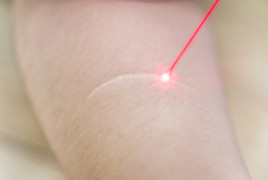Skin cancer types: Squamous cell carcinoma overview
Squamous cell carcinoma of the skin
What is squamous cell carcinoma of the skin?
A common type of skin cancer, squamous cell skin cancer can develop from a pre-cancerous skin growth called an actinic keratosis (AK).
Is it contagious? No
What is squamous cell carcinoma of the skin?
Squamous cells are found throughout the human body. These cells line organs, such as the lungs, throat, and thyroid. We also have squamous cells in our skin.
The job of squamous cells is to protect what lies beneath. In our skin, these cells sit near the surface, protecting the tissue beneath.
Anywhere we have squamous cells, we can develop a type of cancer called squamous cell carcinoma (SCC).
In the skin, this cancer is usually not life-threatening. It tends to grow slowly, but it can grow deep. When the cancer grows deep, it can injure nerves, blood vessels, and anything else in its path. As the cancer cells pile up, a large tumor can form.
Most people who develop this skin cancer have fair skin that they seldom protected with sunscreen or sun-protective clothing. Before developing this skin cancer, they tend to notice signs of sun damage on their skin, such as age spots, patches of discolored skin, and deep wrinkles.
Anyone can develop squamous cell carcinoma
While anyone can develop this skin cancer, you have a greater risk if you live with a transplanted organ, use(d) tanning beds, or have fair skin that you seldom protected from the sun.

Another sign of sun-damaged skin is having one or more pre-cancerous growths on your skin called actinic keratoses (AKs). Some AKs progress, turning into squamous cell carcinoma (SCC) of the skin.
Although SCC is most common in people who have fair skin, people of all colors get this skin cancer. In people who have skin of color, SCC tends to develop in areas that get little or no sun, such as the mouth, genitals, or anus. It’s believed that the cause of the skin cancer in these areas may be an injury or human papillomavirus (HPV) infection.
Whether the cause is sunlight, tanning beds, injury, or an HPV infection, this skin cancer can show up on the skin in various ways, such as a non-healing sore or patch of rough skin.
To find out what this skin cancer can look like and see pictures of it, go to: Squamous cell carcinoma of the skin: Signs and symptoms.
Image
References
 Think sun protection during Skin Cancer Awareness Month
Think sun protection during Skin Cancer Awareness Month
 How to care for your skin if you have lupus
How to care for your skin if you have lupus
 Practice Safe Sun
Practice Safe Sun
 Sunscreen FAQs
Sunscreen FAQs
 Fade dark spots
Fade dark spots
 Hidradenitis suppurativa
Hidradenitis suppurativa
 Laser hair removal
Laser hair removal
 Scar treatment
Scar treatment
 Botox
Botox
 Kids' camp - Camp Discovery
Kids' camp - Camp Discovery
 Dermatologist-approved lesson plans, activities you can use
Dermatologist-approved lesson plans, activities you can use
 Find a Dermatologist
Find a Dermatologist
 Why choose a board-certified dermatologist?
Why choose a board-certified dermatologist?